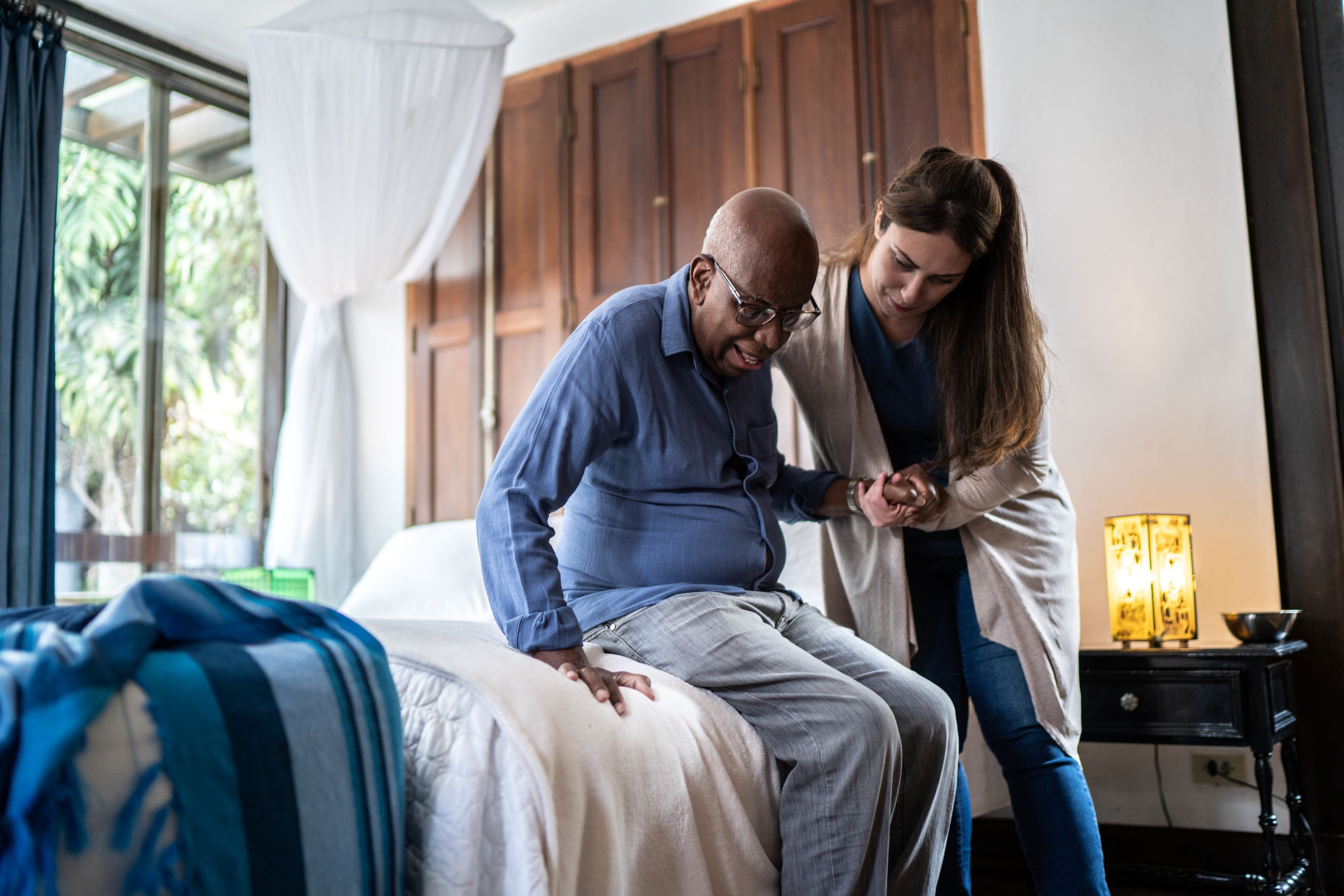Crucial Steps in the Search for the Right Nursing Home
Finding a skilled nursing facility or nursing home after a hospital stay can be daunting. Follow these steps and tips to make the process easier.


After a stay in the hospital, most of us would prefer to go home to recuperate, but that may not be possible. If you or your loved one needs more medical care, rehabilitation or supervision, you'll have to find a nursing home or skilled nursing facility before your loved one is discharged.
Families are often given little time and guidance to make an informed choice. The hospital's discharge planner will provide a long list of facilities but no recommendations. Choose the wrong facility, and stress, confusion and regret will be the result, with profound implications for everyone. Your search should begin as soon as realistically possible. Even better, before a health crisis, create a list of places you would be willing to consider. "The saying goes, 'Discharge starts at admission,'" says Eilon Caspi, a gerontologist at the University of Connecticut, Storrs.
But what should you look for, and who is a good source of impartial information? Nursing homes are a business with marketing personnel whose job it is to sell you on the place, but you need more than glossy brochures and vague promises to go on. Because many nursing homes didn't fare well during the pandemic, you should be especially vigilant in your search now.

Screen for Quality of Care
Nursing homes often specialize in areas of care, like stroke recovery or long-term ventilator support, so ask the hospitalist assigned to your case, as well as your family physician, about the kind of care your loved one will need. A geriatric care manager can often recommend facilities and coordinate the transition from hospital to nursing home.
Whether you have names of places you want to check out or are starting from scratch, kick off your search at Care Compare for nursing homes certified by Medicare and Medicaid, which most are. Facilities are rated for overall care with one to five stars, from lowest to highest quality, based on health inspections, staffing levels and evaluation measures.
Search by facility name or location, and filter the results for those rated with four or five stars. If few options turn up, expand your search geographically and include three-star facilities, which are considered average. Avoid one- or two-star facilities and those that are "special focus facility" candidates or have already been designated that way, as they have been cited for serious deficiencies or problems over multiple years and need additional oversight.
Next, filter your results for nursing homes rated four or five stars for their staffing of nurses and aides. This represents the level of care that residents receive, such as the number of services they get, how long they must wait for them and the amount of time that the staff spends attending to each person, says Lori Smetanka, executive director of the National Consumer Voice for Quality Long-Term Care. After winnowing down your choices, compare the information for up to three facilities simultaneously.
Care Compare isn't perfect; nursing homes self-report the information, and their data is prone to inflation and manipulation. But the Centers for Medicare & Medicaid Services, which manages the tool, has improved its accuracy over the past several years by basing data on verifiable sources, such as staffing levels from payroll data.
Every state has an office of ombudsman for long-term care that fields and resolves complaints about nursing homes and other care facilities. Besides advocating for improvements in long-term care, these offices can share complaint data about a facility such as the number of complaints logged in a given year and what they were for, says Amity Overall Laib, director of the National Long-Term Care Ombudsman Resource Center. To find your state or local ombudsman, visit the National Consumer Voice for Quality Long-Term Care and click on your state.
State survey reports are another resource. To be certified by Medicare and Medicaid, facilities must show they comply substantially with federal and state requirements based on an annual survey that the state department of health oversees. The report lists deficiencies cited and enforcement actions taken, with up to three years of survey reports accessible on Care Compare. Nursing homes and your state's department of health should also make the reports available. Note the number, recency and nature of the deficiencies cited, along with any inadequate infection control, neglect or abuse, says Kristine Sundberg, executive director of Elder Voice Family Advocates, a citizen advocacy group in Minneapolis. Fewer, older and less egregious deficiencies are better. Advocacy groups, such as Elder Voice, can also be a great source of advice.

Ask Plenty of Questions
When you call or visit a nursing home, staff members should be forthcoming and transparent when answering your questions. How they communicate with you during your visit could indicate how they will do so later when your loved one lives there, Smetanka says. Take notes or even record your conversation (with permission if required under your state's law). This can be useful for future reference, not to mention, evidentiary support if needed later, says Suzanne Scheller, an elder law attorney in Champlin, Minn.
You'll probably speak first with the nursing home's director of admissions or director of marketing, who can tell you whether the facility will have a bed available when you need it. This person often isn't a nurse or financial expert, says Caspi. "While many are honest and caring people, others are not, so be mindful of the potential for unfounded promises," he says. Beware customer satisfaction surveys, which may be biased in favor of the facility.
A high vacancy rate may be a red flag. "As a rule of thumb, a facility with few available beds is full for a reason, such as a good reputation and referrals," says Scheller. Be wary of any recent change in management. That usually means a period of disruption, which vulnerable patients can't afford.
Inadequate staffing and high turnover rates are another source of disruption. The appropriate ratio of nurses and aides to residents varies with the time of day and the degree of care the patients need. A recent study by nursing researchers found that a registered nurse can care for nine to 28 residents and an aide five to seven residents during the day when needs are greatest. Nursing homes must post their staffing levels by shift daily. An RN should be available throughout the day and evening to provide adequate supervision, says Caspi.
Despite federal and state regulations, which generally set a low bar, understaffing was widespread and chronic before the pandemic and only worsened during it. Those difficulties still remain. Understaffing leads to neglect when overworked nurses and aides don't have time to meet all the needs of every resident. It also produces high turnover, as staff members burn out and quit, so find out how management attracts and keeps employees.
Because aides will provide hands-on care of your loved one, management should treat them as valued members of the care team, not merely as the bottom rung of a hierarchy. There should also be a process for managing medications and preventing errors, as well as background checks on prospective employees to prevent sexual predation and theft of medications.

Investigate the COVID Track Record
As of late May 2021, nearly 132,000 residents of nursing homes had died of COVID-19 since the pandemic began, comprising about 20% of all COVID deaths in the U.S. With opportunities to socialize and visitation limited or banned for many months, residents suffered from isolation, loneliness, depression and exacerbated memory loss. Although the rates of infection and death have fallen dramatically with safety measures and vaccination of residents, the trauma still reverberates.
Get specifics about the facility's track record, including the number of COVID-19 cases and deaths for residents and staff and when they occurred. Some facilities post that information on their websites, or you can search for it the Centers for Medicare & Medicaid Services.
Even as COVID cases decline, the nursing home should still have measures in place to keep everyone safe. If a new case emerges, will they "lock down," prohibiting indoor visitation again? "No two facilities have the same guidelines or protocols for our visits, even now," says Liz Barlowe, a care manager in St. Petersburg, Fla.
When considering the facility's policies, you'll need to balance accessibility with safety. You must feel comfortable abiding by the policies, which should reflect your values, says Steven Barlam, a care manager in Los Angeles.

Tour the Facility in Person
Many facilities provide virtual tours, but nothing beats an in-person visit where you can use all your senses. If something doesn't look, sound or smell right, ask about it. If facilities know you're coming, they may put on a show. So, after an initial visit, drop by again at an unpredictable time, a practice you should continue throughout your loved one's stay.
What's the vibe? Warm and welcoming? Cold and institutional? You and your family member must feel comfortable here, especially if you anticipate a long-term placement. Don't be misled by a facility's physical appearance. Some look like an elegant hotel but provide mediocre care, while others that seem institutional offer great care. Keep in mind if the facility's appearance is off-putting to family members, they may find it hard to visit, says Barlam.
Take the time to observe how staff members interact with each other and the residents. Are they collegial and caring or just doing their job? Are the residents participating in activities or lined up in a hallway, slumped in wheelchairs? "Many don't arrive like that but end up that way because it's the easiest way to keep an eye on them," says Anne Sansevero, a care manager in New York City. Check bulletin boards to get an idea of the activities on the agenda.

Consider the Financial Side
The national monthly median cost of nursing home care is $7,756 for a semi-private room (ranging from $5,019 in Texas to $37,413 in Alaska) and $8,821 for a private room (ranging from $5,749 in Missouri to $36,378 in Alaska), according to the Genworth 2020 Cost of Care survey.
Medicare will pay for up to 100 days of care per benefit period in a certified skilled nursing facility as long as the care is medically necessary. There are other requirements, so read "Your Guide to Choosing a Nursing Home or Other Long-Term Services & Supports." For the first 20 days, Medicare pays the full cost; for days 21 through 100, you pay coinsurance of up to $185.50 per day in 2021. If you only need long-term custodial care, which includes help with activities of daily living such as bathing, dressing, toileting and eating, Medicare won't cover the cost.
Patients that don't need 100 days of care are discharged sooner. Conversely, if the person declines -- because of, say, advanced dementia, chronic obstructive pulmonary disease, Parkinson's or the effects of a stroke -- short-term rehabilitation could become a long-term placement. At that point, you must pay out of pocket or file a claim if you have a long-term care insurance policy that covers skilled nursing. You may be eligible for Medicaid, but only if your assets fall below a certain level.
In most states, facilities that are certified for Medicare and Medicaid are not required to certify all of their beds. If a Medicaid-certified bed isn't open when you need it, you must pay out of pocket until one becomes available.

Seek Out Help in Your Search
A geriatric care manager who belongs to the Aging Life Care Association can find and coordinate post-hospital care for patients. These care managers know the reputations of facilities in their communities and understand the financial side. Once your loved one is in residence, they can be your eyes and ears as well as advocates.
ALCA-approved care managers must have specialized degrees and experience in human services, such as social work, psychology, gerontology or nursing. Their allegiance is to the client and their family, and they don't accept compensation from services to which they refer clients, says Liz Barlowe, a care manager in St. Petersburg, Fla., and a recent past president of ALCA. Rates typically range from $300 to $800 for an initial assessment and $100 to $200 per hour thereafter, depending on the region. Medicare, Medicaid and private insurers don't cover the cost, but some long-term care policies may pay part of it.
Profit and prosper with the best of Kiplinger's advice on investing, taxes, retirement, personal finance and much more. Delivered daily. Enter your email in the box and click Sign Me Up.

-
 What to Watch for When Refinancing Your Home Mortgage
What to Watch for When Refinancing Your Home MortgageA smart refinance can save you thousands, but only if you know how to avoid costly pitfalls, calculate true savings and choose the right loan for your goals.
-
 The 10 Best Splurge Destinations for Retirees in 2026
The 10 Best Splurge Destinations for Retirees in 2026Come for the luxury vacation. Retire for the lifestyle (if the vacay goes well). What better way to test a location for retiring abroad?
-
 Builders Are Offering Big Mortgage Incentives — What Homebuyers Should Watch For
Builders Are Offering Big Mortgage Incentives — What Homebuyers Should Watch ForBuilder credits and below-market mortgage rates can ease affordability pressures, but the savings often come with trade-offs buyers should understand before signing.
-
 Mom Needs a Nursing Home. Should I Spend Down Her Assets So She Qualifies for Medicaid?
Mom Needs a Nursing Home. Should I Spend Down Her Assets So She Qualifies for Medicaid?We asked expert financial advisers for their advice.
-
 Trump’s Tax Cut Risks Your SNAP, Medicaid Benefits
Trump’s Tax Cut Risks Your SNAP, Medicaid BenefitsTax Cuts The GOP budget blueprint could slash lifesaving programs for millions of U.S. households.
-
 457 Plan Contribution Limits for 2026
457 Plan Contribution Limits for 2026Retirement plans There are higher 457 plan contribution limits in 2026. That's good news for state and local government employees.
-
 Medicare Basics: 12 Things You Need to Know
Medicare Basics: 12 Things You Need to KnowMedicare There's Medicare Part A, Part B, Part D, Medigap plans, Medicare Advantage plans and so on. We sort out the confusion about signing up for Medicare — and much more.
-
 The Seven Worst Assets to Leave Your Kids or Grandkids
The Seven Worst Assets to Leave Your Kids or Grandkidsinheritance Leaving these assets to your loved ones may be more trouble than it’s worth. Here's how to avoid adding to their grief after you're gone.
-
 SEP IRA Contribution Limits for 2026
SEP IRA Contribution Limits for 2026SEP IRA A good option for small business owners, SEP IRAs allow individual annual contributions of as much as $70,000 in 2025, and up to $72,000 in 2026.
-
 Roth IRA Contribution Limits for 2026
Roth IRA Contribution Limits for 2026Roth IRAs Roth IRAs allow you to save for retirement with after-tax dollars while you're working, and then withdraw those contributions and earnings tax-free when you retire. Here's a look at 2026 limits and income-based phaseouts.
-
 SIMPLE IRA Contribution Limits for 2026
SIMPLE IRA Contribution Limits for 2026simple IRA For 2026, the SIMPLE IRA contribution limit rises to $17,000, with a $4,000 catch-up for those 50 and over, totaling $21,000.
